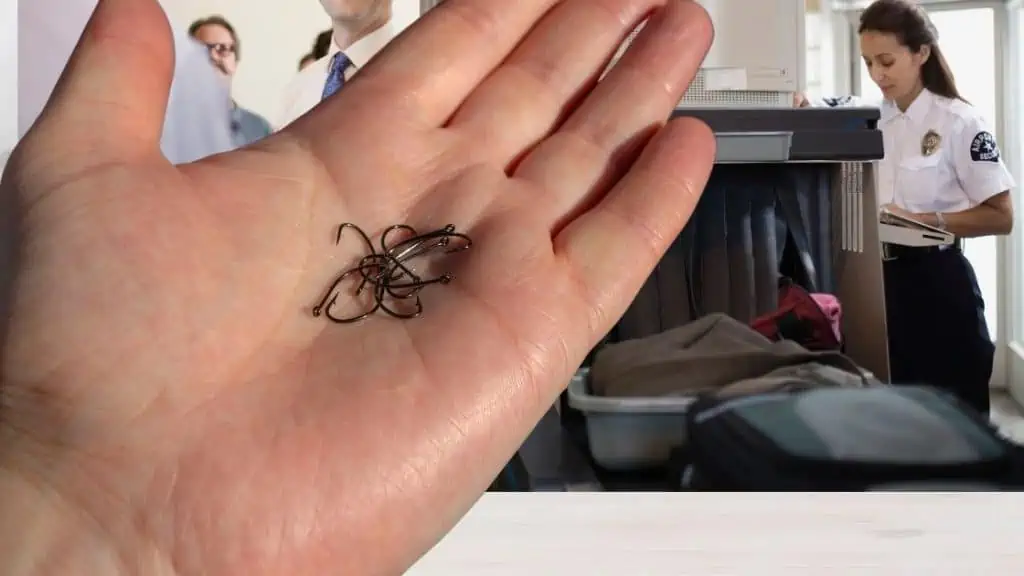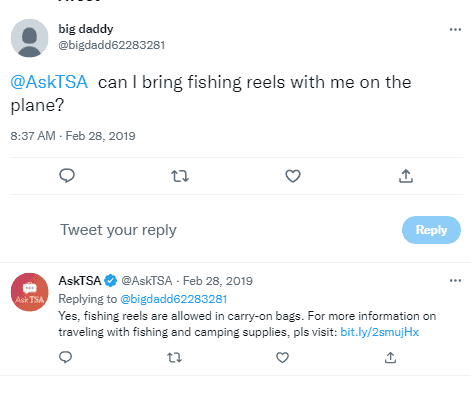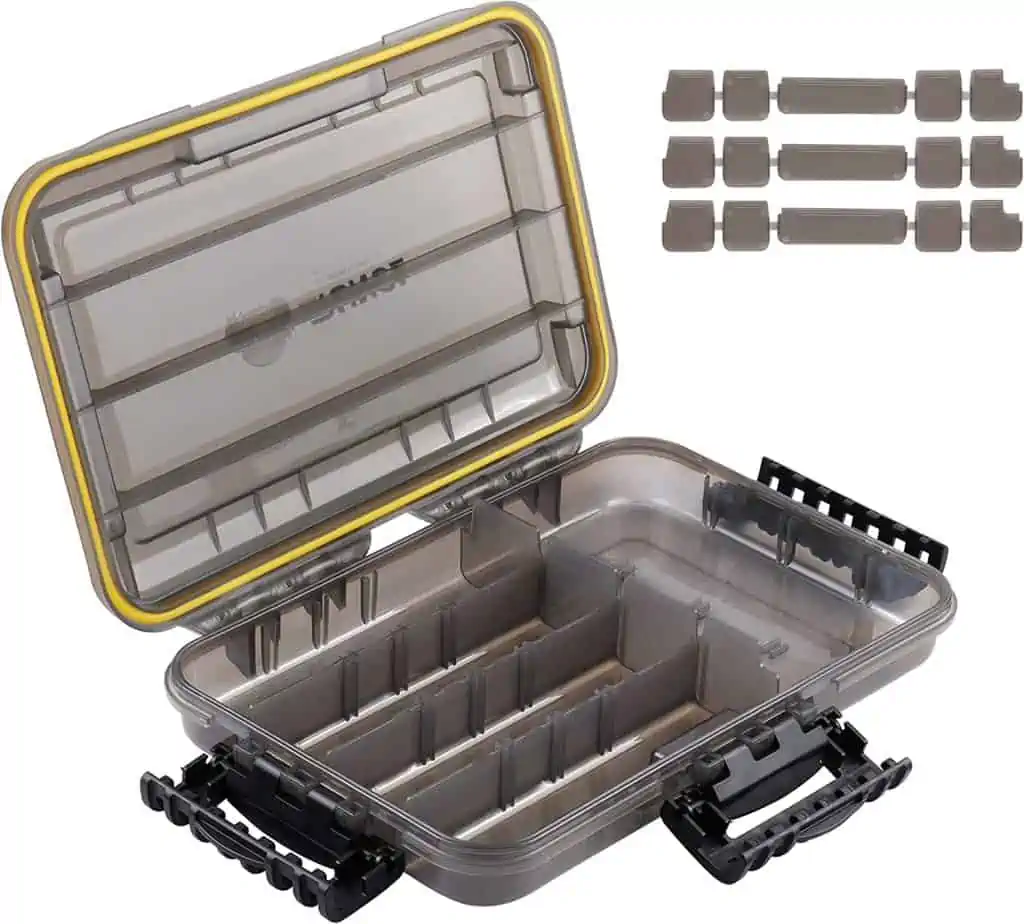You’re probably planning a memorable fishing destination trip with your family or friends and gathering your fishing gear to take along. But then, a question arises in your mind, ‘Can you bring fishing hooks on a plane?’
You wouldn’t want your fishing hooks unexpectedly confiscated, leaving you disappointed at the start of your trip.
Find out how you can bring fishing hooks on a plane in your carry-on and checked bags.

The Quick Answer: Can I bring fishing hooks on a plane? According to TSA fishing hooks can be carried in your carry-on provided they are small, while anything bigger must be packed in your checked baggage.
Contents
Can You Take Fishing Hooks Through Airport Security?
While small hooks are permitted in carry-on bags, the final decision to let it through or take it out lies in the hands of the TSA officer at the security checkpoint.
For reference, consider scissors allowed through airport security in your carry-on only if the blade is not longer than 4 inches.
If you must carry your fishing hooks in your carry-on, you could write an email to the airline enquiring about carry-on regulations.
If they provide an affirmative answer, it would be best to print the same and use it at the airport security in case you need to talk it out.

Can You Pack Fishing Hooks in Checked Bags?

TSA mentions that any sharp fishing tackle that could be considered dangerous, like large fish hooks, must be sheathed, securely wrapped, and packed in your checked luggage.
There are no limits on how many fishing hooks you can carry in checked bags. You can take any size hooks, small or big, in your checked luggage.
Unfortunately, TSA doesn’t specify what length hooks constitute a large size. However, hooks used for deep sea fishing count as larger ones that must be packed in checked bags.

Can You Take Fishing Hooks on an International Flight?
If you’re flying to an international destination, the rules may differ in the country you’re headed to. This is because the TSA has authority only in the USA.
Many international flights allow fishing gear either packed in a carry-on or in your checked luggage. However, you can’t be too certain about what you’ll be permitted with; a quick call to the airlines will be helpful before you start packing.
You could pack your fishing hooks in your checked bags to be safer when flying internationally.
How to Pack Fishing Hooks to Bring on a Plane?
Whether you’re taking smaller fishing hooks in your carry-on or larger ones in your checked luggage, it is essential to pack them safely.
Sharp fishing hooks seem like something that could be a weapon, which is why they should be sheathed (with a protective covering) and safely packed in your luggage.
Consider purchasing a fishing hook container. It would simplify your packing hassles.
Are There Any Packing Limits For Fishing Hooks?
TSA doesn’t specify such limits, implying that you could bring along as many fishing essentials as you may require, so long as it doesn’t exceed the luggage weight limitations.
If your luggage is overweight, you could always pay the additional charges for the extra baggage.
Although, with fishing essentials, it would be best not to go overboard with how much you pack, especially for a single trip – the minimal fishing gear would suffice.
What About Other Fishing Gear?

You’ll obviously want to take along more than just fishing hooks on your trip. As for the other fishing gear, here’s what you need to keep in mind.
Fishing Pole
While TSA states that fishing poles can be packed in carry-on and checked bags, the airlines have the final say. So check with the airlines you’re flying with to know if they permit a fishing rod to be carried onboard.
Airlines have size limitations for carry-on items; confirm with the airline that your fishing rod fits within the restriction.
Fishing Reels
Reels are much less complicated to travel with. In addition, TSA clearly states that you can carry your fishing reels in your carry-on.
However, they don’t specify the extra spools or the fishing line that may be on the reels. The final call rests on individual TSA agents who will check all the fishing equipment.
It would be best to pack an extra spool in your checked luggage or buy a new fishing line at your destination. Typically, the rod length mustn’t exceed 277cm (109”).

Fishing Lures
These sharp objects might only be allowed as a carry-on if packed well. However, among the various sizes of fishing lures, the smaller ones are ideal for taking along for air travel.
Large ones aren’t allowed even in checked luggage on most airlines. So if you must take these along, check the airline’s guidelines and pack them in your checked baggage.
Fishing Pliers
Fishing pliers within 7 inches can be brought in carry-on and checked bags. Pliers that exceed 7 inches must be packed in your checked bag.

Miscellaneous Equipment
Knives, metal rod holders, and liquid fly floatant must be mandatorily checked-in.
If you’re carrying a lot of fishing equipment and are unsure about the restrictions, arriving at the airport at least an hour earlier than usual would be wise. It’ll allow extra time to shift things between your carry-on and your bags to check-in.
Fishing magnets, like low-powered magnets, are safe to carry on the plane as long as they’re reasonably sized.

Summary
Small fishing hooks can be brought on planes in your carry-on or checked baggage.
The larger ones, considered dangerous, aren’t permitted in the cabin and will be taken away at airport security. These must be securely wrapped and packed in your checked luggage to ensure no harm to any TSA officer who might inspect your luggage.
If you wish to bring any of your catch home with you then you will need to know whether you can take fish on a plane.
Further Airport Security Articles
Here are some other articles you’d be interested in from my site.
- Can You Take Aerosols on a Plane?
- Can You Bring Metal on a Plane? Carry on and Checked Bags
- Can You Bring a Pocket Knife on a Plane?

I have been traveling around the world by air since the early 70s and living overseas too. I worked for British Airways for a number of years and I am also a private pilot. About Me



